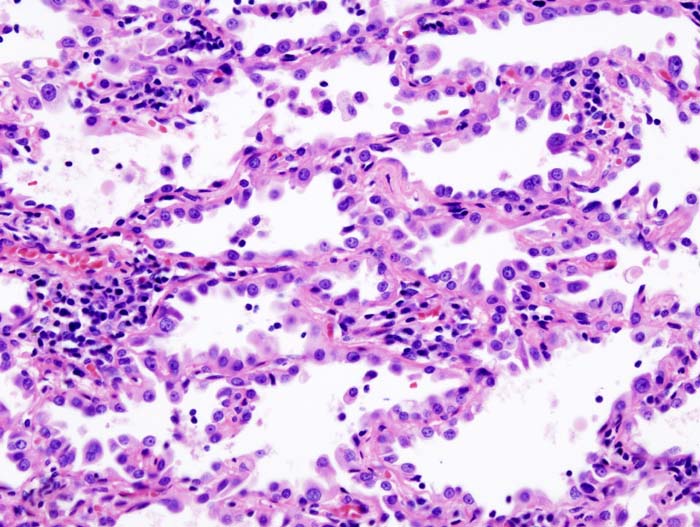Atypical adenomatous hyperplasia
File:Pulmonary adeocaricnoma (1) localized noninvasive type.jpg  File:Pulmonary adeocaricnoma (3) localized noninvasive type.jpg
File:Pulmonary adeocaricnoma (3) localized noninvasive type.jpg  Atypical Adenomatous Hyperplasia (AAH) is a pathological condition that occurs in the lungs. It is considered a precursor lesion to adenocarcinoma, which is a type of cancer that can occur in various organs but is most commonly found in the lungs. AAH is characterized by the abnormal proliferation of epithelial cells within the alveoli, the tiny air sacs in the lungs, leading to the formation of small, atypical glandular structures. This condition is often discovered incidentally during imaging studies for other reasons or in lung tissue samples taken for other purposes.
Atypical Adenomatous Hyperplasia (AAH) is a pathological condition that occurs in the lungs. It is considered a precursor lesion to adenocarcinoma, which is a type of cancer that can occur in various organs but is most commonly found in the lungs. AAH is characterized by the abnormal proliferation of epithelial cells within the alveoli, the tiny air sacs in the lungs, leading to the formation of small, atypical glandular structures. This condition is often discovered incidentally during imaging studies for other reasons or in lung tissue samples taken for other purposes.
Diagnosis[edit | edit source]
The diagnosis of AAH is typically made through a combination of radiological imaging and histopathological examination. On CT scans, AAH lesions can appear as small, ground-glass opacities with ill-defined borders, although these findings are not specific to AAH and can be seen in various other lung conditions. Histopathologically, AAH is characterized by the proliferation of mildly to moderately atypical cells lining the alveolar walls. These cells have enlarged, hyperchromatic nuclei and may form small papillary or acinar structures, but they do not invade the surrounding lung tissue, which is a key feature distinguishing AAH from adenocarcinoma.
Treatment and Prognosis[edit | edit source]
The management of AAH depends on several factors, including the size and number of lesions, as well as the patient's overall health and risk factors for lung cancer. In many cases, AAH lesions are monitored with periodic imaging to detect any changes in size or appearance that might indicate progression to adenocarcinoma. Surgical intervention may be considered for lesions that show significant growth or have suspicious features on imaging.
The prognosis for individuals with AAH is generally favorable, as it is a pre-malignant condition and does not invade surrounding tissues. However, the presence of AAH indicates an increased risk of developing lung adenocarcinoma, and patients are often advised to undergo regular follow-up and potentially modify risk factors for lung cancer, such as smoking cessation.
Epidemiology[edit | edit source]
AAH is more commonly found in individuals with a history of smoking, although it can also occur in non-smokers. The prevalence of AAH is difficult to determine accurately, as it is often an incidental finding, but it is considered relatively rare in the general population. The condition is more frequently diagnosed in East Asian populations, although the reasons for this geographical variation are not fully understood.
Pathogenesis[edit | edit source]
The exact mechanism underlying the development of AAH is not well understood, but it is thought to involve genetic mutations and alterations in the signaling pathways that regulate cell growth and differentiation. These changes lead to the clonal expansion of atypical epithelial cells, which can eventually progress to invasive adenocarcinoma if additional genetic alterations occur.
See Also[edit | edit source]
Atypical_adenomatous_hyperplasia[edit | edit source]
Pulmonary adeocaricnoma (2) localized noninvasive type
Pulmonary adeocaricnoma (3) localized noninvasive type
Pulmonary adeocaricnoma (4) localized noninvasive type
Search WikiMD
Ad.Tired of being Overweight? Try W8MD's physician weight loss program.
Semaglutide (Ozempic / Wegovy and Tirzepatide (Mounjaro / Zepbound) available.
Advertise on WikiMD
|
WikiMD's Wellness Encyclopedia |
| Let Food Be Thy Medicine Medicine Thy Food - Hippocrates |
Translate this page: - East Asian
中文,
日本,
한국어,
South Asian
हिन्दी,
தமிழ்,
తెలుగు,
Urdu,
ಕನ್ನಡ,
Southeast Asian
Indonesian,
Vietnamese,
Thai,
မြန်မာဘာသာ,
বাংলা
European
español,
Deutsch,
français,
Greek,
português do Brasil,
polski,
română,
русский,
Nederlands,
norsk,
svenska,
suomi,
Italian
Middle Eastern & African
عربى,
Turkish,
Persian,
Hebrew,
Afrikaans,
isiZulu,
Kiswahili,
Other
Bulgarian,
Hungarian,
Czech,
Swedish,
മലയാളം,
मराठी,
ਪੰਜਾਬੀ,
ગુજરાતી,
Portuguese,
Ukrainian
Medical Disclaimer: WikiMD is not a substitute for professional medical advice. The information on WikiMD is provided as an information resource only, may be incorrect, outdated or misleading, and is not to be used or relied on for any diagnostic or treatment purposes. Please consult your health care provider before making any healthcare decisions or for guidance about a specific medical condition. WikiMD expressly disclaims responsibility, and shall have no liability, for any damages, loss, injury, or liability whatsoever suffered as a result of your reliance on the information contained in this site. By visiting this site you agree to the foregoing terms and conditions, which may from time to time be changed or supplemented by WikiMD. If you do not agree to the foregoing terms and conditions, you should not enter or use this site. See full disclaimer.
Credits:Most images are courtesy of Wikimedia commons, and templates, categories Wikipedia, licensed under CC BY SA or similar.
Contributors: Prab R. Tumpati, MD

